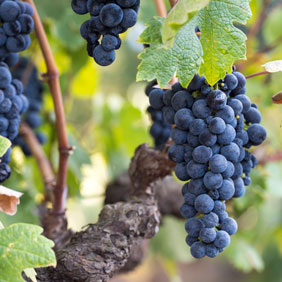California Zinfandel
Details:
In recent history, Zinfandel was California’s “mystery grape” because its origins were unknown. DNA fingerprinting has confirmed that Italy’s Primitivo and Crljenak Kastelanski, an ancient Croatian variety, are genetically identical to Zinfandel grapes. However, differences in vine vigor and cluster size distinguish Zinfandel from its genetic twins, and further differences in cultivation, terroir and winemaking combine to give California Zinfandel its own particular flavor profile with a truly American name, history and style. On wine labels, U.S. regulations require that Zinfandel and Primitivo be identified separately.
Studies indicate that the grape used for making California Zinfandel probably originated in Croatia. Historians believe that in the 1820s, a nursery owner brought Zinfandel cuttings that were Croatian in origin to the United States from an Austrian collection. The Zinfandel name, however, is truly American—the earliest and only documented use of the name is in America where a Boston nursery owner advertised Zinfandel for sale in 1832.
Zinfandel was introduced to California during the Gold Rush somewhere between 1852 and 1857 and became widely planted because it thrived so well in the state’s climate and soil. Today, Zinfandel is the third-leading winegrape variety in California, with more than 44,400 acres planted and 416,615 tons crushed in 2016, according to the California Department of Food and Agriculture. It is grown in 45 of California’s 58 counties. Although Zinfandel is a red winegrape, the majority of Zinfandel grapes is used to make a rosé (blush) wine called White Zinfandel. Promoted to the world by the state’s vintners for more than 130 years, Zinfandel has grown beyond cult status and is now internationally recognized due to the unique character and high quality wines that are produced only in the Golden State.
Popular descriptors for red Zinfandel include blackberry, raspberry, boysenberry, cherry, as well as black pepper, cloves, anise and herbs.
Advocacy Group: Zinfandel Advocates and Producers (ZAP) is a nonprofit association that organizes seminars, educational programs and wine tastings across the U.S. to promote Zinfandel and its high quality reputation. Their annual Zinfandel Experience in January in San Francisco is the largest single varietal tasting of its kind. ZAP supports research surrounding the history and origins of the Zinfandel grape. Web site: www.zinfandel.org.
Top California Counties for Zinfandel Acreage 2016
| Counties | 2016 Total Acres |
|---|---|
| San Joaquin | 18,191 |
| Sonoma | 5,052 |
| Fresno | 3,291 |
| Madera | 2,420 |
| Amador | 2,028 |
| San Luis Obispo | 2,027 |
| Mendocino | 1,861 |
| Napa | 1,415 |
| Kern | 1,184 |
| Sacramento | 1,084 |
| Other | 5,893 |
| TOTAL | 44,446 |
Source: California Agricultural Statistics Service
California Zinfandel Winegrape Crush
| Year | Tons Crushed |
|---|---|
| 2016 | 416,615 |
| 2015 | 388,396 |
| 2014 | 355,599 |
| 2013 | 469,216 |
| 2012 | 448,039 |
| 2011 | 345,168 |
| 2010 | 394,177 |
| 2009 | 446,942 |
| 2008 | 397,982 |
| 2007 | 407,630 |
| 2006 | 341,874 |
| 2005 | 448,144 |
| 2004 | 321,899 |
| 2003 | 327,701 |
| 2002 | 369,772 |
| 2001 | 336,547 |
| 2000 | 404,167 |
| 1999 | 324,397 |
| 1998 | 339,712 |
| 1997 | 421,595 |
| 1996 | 299,843 |
| 1995 | 326,694 |
| 1990 | 185,492 |
| 1985 | 123,370 |
| 1980 | 115,971 |
| 1976 | 72,790 |





